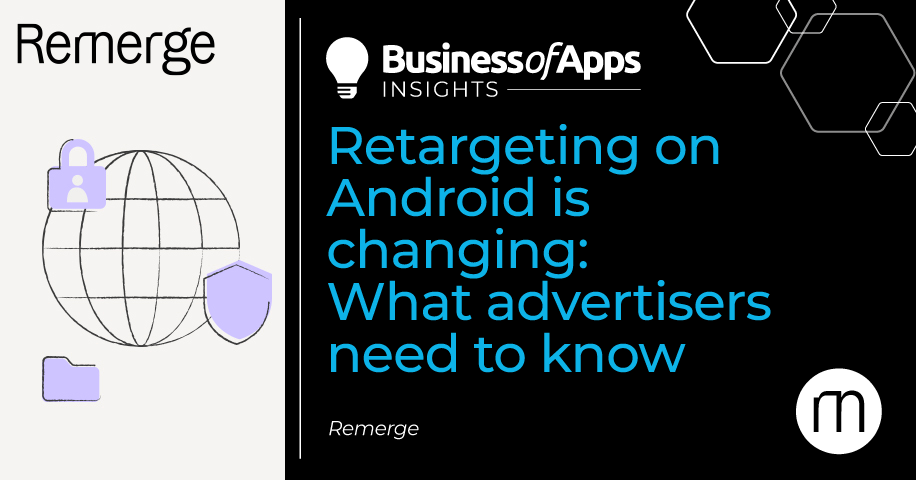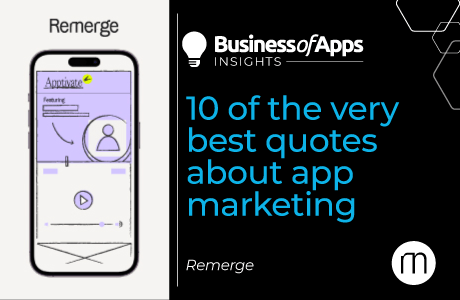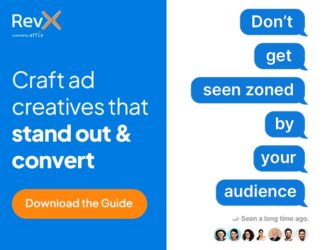As consumer demand for privacy grows ever stronger, Google has begun building privacy-centric advertising solutions that will change the way user data is leveraged for retargeting campaigns. But what does that mean for advertisers and how can mobile marketers adapt to ensure that retargeting on Android continues to drive value? To find out, hear from Güven Soydan, who has led several product teams throughout his 14-year career in digital advertising. Today, as VP of Product at Remerge, Güven and his team are among the first to work directly with Google on the development of their new advertising framework.
How does programmatic in-app retargeting work compared to other strategies like user acquisition (UA)?
Programmatic advertising outcomes are largely influenced by four critical elements: creative design, targeting, bidding, and budget allocation. The latter two, (bidding and budgeting), help to determine the predicted value of an ad impression, which is also contingent on the segment of users that the ads are shown to. This bidding process is usually governed by machines because impression prices change dynamically and are driven by market demand.
If you first look at user acquisition (UA), (which accounts for a major portion of the in-app advertising market), the total addressable market is massive compared to the available budgets. Success often lands in niche verticals like casual gaming or remains elusive due to the complex task of targeting and segmentation. Targeting specific publishers or interest areas is common practice, and although valuable, it’s hyper-competitive – which often leads to advertisers bidding against each other.
Retargeting on the other hand is different in the sense that it targets individuals already interested in your product – it’s akin to fishing in a pool rather than the ocean. Coupled with a detailed understanding of customer behavior within your app, it offers huge advantages for targeting – particularly when paired with the appropriate algorithms, data science techniques, and the right expertise.
Moreover, in-app retargeting focuses on a wider variety of objectives and conversion funnels, such as boosting engagement, reducing churn, or increasing purchase size per user – just as Customer Relationship Management (CRM) does. As a result, the focus shifts to optimization for re-engagement and retention – rather than UA’s typical goals of installation and onboarding. Retargeting, therefore, promotes repetition and sustainability to drive retention and combat user churn.
All these factors contribute to making retargeting incredibly beneficial for established app products with a large and segmentable customer base. Especially in times when macroeconomic factors impact both companies and consumers, retargeting offers a wealth of opportunities due to its versatility and its potential to cost-effectively reach your most likely-to-convert users.
Why is mobile advertising going privacy-first?
The transition toward privacy-first mobile advertising mirrors a significant consumer trend in the digital age. This trend is the aftershock of a seismic event – the surge of hyper-personalization in digital experiences, which was heightened by the advent of social media. Today’s digital products, such as personalized feeds, playlists, gaming experiences or job and purchase recommendations, owe their existence to ingenious product managers, engineers and designers who have harnessed behavioral data.
However, this data-driven personalization and the subsequent value created for advertisers by free services has given rise to unforeseen consequences. It’s evident from our brief journey through the last century how advertising, public relations, propaganda, and psychology are intricately linked. Yet, it wasn’t until the mid-2010s that the impact of digital products with access to personal behavioral data was felt – even influencing critical decisions like democratic elections. Simultaneously, or perhaps slightly earlier, a more straightforward question arose: who has access to this data?
Data privacy, (which is critical in the relationships between nations), has hit a crucial juncture as it impacts people from all walks of life – from citizens to nation leaders. A perfect storm of consumer apprehension and classified information has emerged. Revelations of rampant data collection, made public by whistleblowers, have triggered serious calls to action. This set the stage for regulations like GDPR to establish order in what was becoming the wild west of data.
The advent of GDPR and similar laws sparked a global awareness surge due to company compliance requirements which pushed advertising into the spotlight. Interestingly, advertising within walled gardens, (such as social media platforms), largely escaped this scrutiny – possibly due to the user experience. This may be because users typically only have to consent once to their data being shared – something they do when they initially sign up for these platforms.
Post-GDPR, the user experience became arduous as users were required to repeatedly grant consent to consume content, play games, or use services. This also exposed users to the extent of data sharing with multiple partners, raising privacy concerns. I believe this experience was deliberately designed to mainstream privacy demands. Apple responded by integrating this demand into their product core, leveraging their strengths in encryption, security, and reliability, and introducing an OS-level mandatory consent framework called App Tracking Transparency (ATT), for all iOS developers. The unfolding of these events is now part of tech history.
In summary, the shift towards privacy-first mobile advertising is a classic consumer response to market dynamics, largely fueled by the democratic and bureaucratic power that citizens have to drive change.
Why does the privacy-first era matter for advertisers?
Advertisers should prioritize privacy because it aligns with their customers’ desires. The global free market has often operated on a ‘push the boundaries until you’re stopped’ principle. While this may not change soon, experience shows that in the long haul, companies attentive to their customers’ needs and concerns are those who tend to prosper most. They win business by delivering high-quality products and services at prices their customers are willing to pay. Likewise, advertising that respects privacy boundaries fosters healthier long-term relationships with potential and existing customers.
Beyond this ethical imperative, there are also practical considerations. Privacy-first advertising necessitates changes to algorithms, database infrastructures, in-app event collection technologies, relations with third-party technology providers, and segmentation decisions. Failure to adapt to a privacy-first approach, both in compliance and transformation, can lead to significant long-term business impact. Working with the right partners and building skilled teams internally to navigate this shift is crucial. The earlier that businesses start this transition, the better – as expertise in this area will be a valuable strategic investment for the future.
What is Google’s solution for a privacy-first future of Android retargeting?
Google is spearheading the privacy-first future with its Privacy Sandbox, a suite of tools and frameworks for app and web developers to build privacy-centric advertising solutions. The Sandbox addresses various facets of the advertising ecosystem and technology that (1) interacts with user data and (2) facilitates non-personal data sharing across partners. It provides solutions for tracking and reporting via the Attribution API, targeting through the Topics and Protected Audiences API, and data collection and handling via the SDK Run Time.
How is Remerge helping as a mobile DSP, and AppsFlyer as an MMP?
Remerge and AppsFlyer are working directly with Google to play a defining role in the development of this privacy-first solution for mobile retargeting and segmentation. After substantial development, we’ve crafted a solution enabling advertisers to target their existing users through the Remerge platform, with the AppsFlyer SDK enabled in their app. As a first iteration for our customers, our objective is to provide advertisers with a seamless transition, where their experience remains largely unchanged, but a user’s personal data never leaves their mobile devices. This preserves their privacy, which is the fundamental goal of our work with leading Mobile Measurement Partners (MMPs) and Supply Side Partners (SSPs).
Remerge as a DSP is at the front and center of the change when it comes to building products on the Protected Audiences API. Not only do we aim to support the Protected Audiences API, but also the Attribution API too – and in doing so, adapt Remerge’s optimization algorithms to function within this new framework.
Retargeting on iOS had to be relearned when Apple rolled out ATT. How do you think the rollout of Google’s Privacy Sandbox will compare?
The development of the Privacy Sandbox has been underway for some time, having been announced in August 2019, and it has already been implemented on Chrome with the ongoing depreciation of cookies. The myriad of involved parties and developers, as well as the solutions offered for industry-wide challenges, highlight Google’s thoughtful approach to the subject.
For Android, Remerge has been engaged from the early stages in designing and constructing solutions. The reception from advertisers and the broader industry has been very positive. The collaborative effort and intellectual investment in this process are fostering a community-oriented dynamic that will benefit the entire industry in the years to come. So, indeed, I believe that this transition has been, and will continue to be, significantly smoother than ATT was.
How will retargeting on Android work when device IDs like IDFA or GAID can no longer be used?
To answer this, we need to briefly delve into the current retargeting flow. Presently, retargeting via Real Time Bidding (RTB) operates as follows below. However, it should be noted that differences exist in walled gardens, where the Demand Side Platform and Supply Side Platform are already integrated.
- App user behavior is tracked and users’ IDs are added to segments either in real-time or retrospectively (daily). These segments are defined according to various criteria, based on the advertiser and DSP’s decisions, such as users who haven’t purchased anything in the last 7 days, or users who completed a tutorial but have not played a certain level for example.
- When a user engages with an app that uses ads for monetization, their advertising ID is passed to the Supply Side Platform’s SDK (Software Development Kit), which then transfers this information to the DSPs.
- The DSPs match the user’s ID with their segment lists to see if there are any suitable ads for this individual.
- The DSP sends the ad to the SSP along with a bid price for that ad impression.
- An auction is held among the DSPs’ bids, and the winning ad is sent to the app to be displayed.
- Mediation often comes into play in most apps to ensure maximum income for the app publisher.
- In cases of mediation, the winning ads are taken by the mediation SDK and another short auction occurs among the winners of the SSPs.
- The winning ad is displayed, and information about the ad being shown, watched, and possibly clicked, is sent to the DSP.
- The DSP sends this information to the measurement partner.
- The measurement partner tracks all events of all users on the advertiser’s app, enabling them to attribute certain events to the ads that are shown to, or clicked by the user.
With Android Privacy Sandbox, this flow is now undergoing significant technological changes. The difference lies in the fact that while user segments are still defined by the advertiser and potentially the DSP, the user is added to the ‘segment’ in advance and on device, rather than the DSP servers evaluating if a potential ad placement is for a user belonging to a ‘segment’.
Moreover, ad selection decisions are not made in real time. Instead, some ads that are suitable for a segment are sent beforehand – and are selected on the device itself. This means that the additional calculations for pricing and ad selection are done in a completely privacy-centric way. Whatsmore, the user data collected by all the SDKs is controlled by the advertiser – and the SDKs are no longer embedded in the apps that the users enjoy – therefore providing strong protection.
In summary, while almost everything will change from the technology providers’ perspective, the advertiser will see minimal change in the buying experience, except in the ability for absolute personalization. The most notable change will likely be in personalized ads that display products or services perfectly tailored to a user’s behavior or consumption habits. For example, due to the absence of user-level behavioral data, it will no longer be possible to show users products that they added to their shopping cart, but did not end up buying.
This shift will spur substantial innovation in the industry, (which I’ll touch on later), but the overall need for creating value won’t change – necessitating investment in new or additional ways to engage users.
What can advertisers do now to prepare for an ID-less future?
As the industry builds the mobile retargeting tools of tomorrow, it’s important for advertisers to express their needs, ask about possibilities, and emphasize their specific use cases to help product developers and engineers address problems and design the appropriate solutions. Maintaining contact with experienced advertising partners like Remerge will be beneficial as we navigate this transition to Google’s Privacy Sandbox.
What should advertisers look for in a DSP to ensure great retargeting results in the privacy-first era?
For effective retargeting in the future of privacy-safe advertising, crucial components include adept segment management and decision-making capabilities for budget distribution, bidding, and ad selection. Also, a DSP must be able to effectively employ algorithmic optimization that utilizes anonymized and aggregated data.
Remerge stands out by offering these key capabilities, combined with a deep understanding of industry dynamics, value creation metrics, and a unique company culture. We have extensive experience in in-app retargeting, working with a diverse range of customers across the globe from a variety of different industries.
Remerge has a clear and pragmatic strategy to ensure a smooth transition for our clientele of advertisers when the Android Privacy Sandbox rolls out. Here’s a more detailed overview of our plan:
Promote a breadth-first product design approach
We are committed to covering a wide range of topics before delving into specific long-term problems in certain areas. We are striving to become generalists in the Android Privacy Sandbox space before tackling niche subjects.
Stakeholder-centric product development
We are committed to producing well-thought-out, extensively tested, and well-documented products that are designed in close collaboration with our clients and stakeholders.
Leverage existing knowledge
We aim to build upon the wealth of knowledge and technical concepts we’ve built over the years, avoiding the need to reinvent the wheel. We aim to reuse existing technical concepts while considering possible improvements in our new, decentralized bidding approach.
Cultivate industry relationships
Our goal is to strengthen our position as leaders of in-app retargeting and continue to collaborate with new and existing partners. We conduct regular meetings with Google, the major MMPs, and SSPs too.
As part of our strategy, we are also investing in algorithmic optimization to ensure the best outcomes for advertisers. We’re not just refining our product, but evolving together with our partners at the industry forefront, making Remerge a valuable partner for advertisers in the future of privacy-safe advertising.
Do you have any predictions for mobile retargeting in the privacy-first era?
Looking ahead, it appears that the significance and value derived from first-party data will grow exponentially. This will likely bring CRM, analytics and advertising products closer together than ever before. Both in B2B and B2C businesses, a company’s ability to craft customer lifetime management experiences will increasingly define success, particularly given their dependence on marketing, and the retargeting aspect of it. While it’s uncertain exactly how this will transpire, we may witness mergers between large CRM companies and advertising technology companies aiming to create a holistic circle of customer engagement for retention purposes.
Another trend likely to emerge even faster is the enhanced importance of ad creatives and content, combined with the power of generative AI. As devices become more sophisticated, running these algorithms on users’ mobile phones will become a fascinating challenge for advertising technology builders.
I foresee that advertising products in the next few years will generate personalized ad experiences for each individual, right on their device, without sharing their data with anyone except the AI on the device. Imagine ads for products not pulled from an e-commerce company’s product feed, but from the photos on your phone.
The AI would analyze your style and show you products you’d love, possibly even items that don’t yet exist. But once you’ve expressed interest and liked how it looked on you (via the AI-generated image in the ad), manufacturers can use this information to refine and develop their ranges and create even more desirable products for their customers.
While this may sound like a distant dream, I firmly believe it’s not far off. We’re on the precipice of a major shift in advertising, one that combines advanced technology with a deep understanding of consumer preferences to create more personalized and effective ad experiences.
Apple is now showing interest in building their own privacy-safe retargeting solutions. What are your thoughts?
While the specific details are not yet clear, there are indications, such as the updates in SKAdNetwork 5.0 that support remarketing attributions, suggesting that Apple might be considering more active involvement in the space.
However, it’s important to note that the shift of advertising dollars to Android has strengthened and diversified the ecosystem there. Combined with Google’s collaborative approach to building a privacy-first advertising future, Apple may be realizing the need for a healthy, functioning ecosystem without compromising its main lifeline – in-app advertising.
Apple’s strategy to distribute value through its payment and subscription services to creators hasn’t resonated well with the market, affecting both developers and advertisers operating on iOS. Retargeting could be a part of a larger plan where Apple aims to invigorate the advertising-fueled economy that its own products haven’t fully supported yet.
Given the amount of work Apple has put into its own advertising platform, retargeting is likely to be a crucial part of their strategy to remain competitive with other market offerings. It’s certainly an area to watch closely as the landscape continues to evolve.












